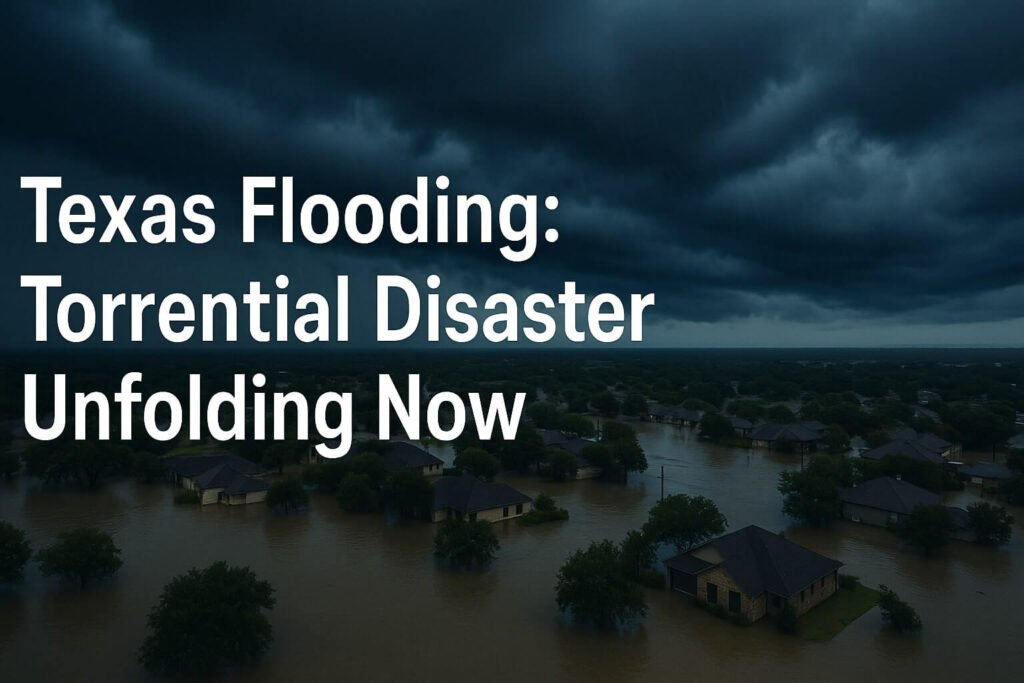The heart of Texas is drowning, and it’s not a figure of speech. As skies opened up over the Hill Country this week, a wave of destruction swept through towns like Kerrville, Hunt, Comfort, and beyond. What began as heavy overnight rainfall quickly turned into a life-threatening emergency. With over 10 inches of rain falling in some places, the result was not just waterlogged streets but raging rivers that rose feet within minutes. The Texas flooding now unfolding is more than a weather story. It’s a human story. One of rescue, loss, heartbreak, and survival.
The Guadalupe River, often a peaceful flow through central Texas, turned feral. Near Camp Mystic, it surged 26 feet in just 45 minutes. The water didn’t just rise, it exploded upward, swallowing banks, homes, and roads in its path. As of the latest reports, at least 24 people have died, many of them children and staff swept away from summer camps near Hunt. First responders were forced to abandon vehicles and switch to airlift rescues as entire neighborhoods vanished under floodwater.
More than 500 members of Texas Task Force 1 and the National Guard are now operating in full rescue mode. High-water vehicles, helicopters, and boats are combing rural backroads and river bends, searching for the missing. Shelters are filling fast. Churches, school gyms, and civic centers in Boerne, Fredericksburg, and San Antonio are packed with families displaced from their homes.
Texas flooding often strikes fast. But this event is unusual in both intensity and scope. Rainfall totals surged beyond the ten-inch mark in multiple counties, including Kerr, Kendall, and Comal. The soil was already saturated from earlier spring rains. With nowhere for the new water to go, it became surface runoff. Every creek, arroyo, and low crossing turned into a trap.
The Guadalupe River was not alone. The San Saba River, Pedernales, Blanco, and Medina all pushed past their banks. Real-time USGS river gauges showed flood stage exceeded by double digits in less than two hours. In Brady and Menard, residents saw rivers outside their windows that had been dry just days earlier.
Interstate 10 near Comfort was shut down for hours. Smaller farm-to-market roads crumbled under the pressure. Bridges gave out. And entire rural areas were cut off, not just by water, but by debris fields of uprooted trees, snapped telephone poles, and overturned vehicles.
Governor Greg Abbott issued a disaster declaration early Friday, enabling a faster federal response. That opened the gates for FEMA coordination and emergency funds to flow in. But even with help arriving, the situation remains unstable. The Weather Channel predicts more rainfall over the next 48 hours. Models show at least another 1 to 2 inches possible. That may seem small, but for rivers already bursting, it can reignite flash flooding instantly.
In Hunt, where the devastation was most severe, dozens of families are still awaiting word from missing loved ones. Camp Mystic, a private girls’ camp on the Guadalupe, was the site of a dramatic airlift. Twenty-three campers were initially unaccounted for. Crews rescued some from tree limbs and rooftops, but several remain missing.
The emotional toll is heavy. This isn’t just weather anymore. It’s trauma. It’s children forced to sleep in gymnasiums, parents desperately trying to get signal to call relatives, and elderly residents in mobile homes cut off from medication. It’s first responders working without sleep, dragging boats through downed power lines and collapsed driveways, hoping to find signs of life.
Hydrologists say this will be a long recovery. Downstream communities like Victoria and Cuero are next in line. The floodwaters that surged through Kerrville will move southward through the Guadalupe basin over the coming days. This means towns that haven’t yet seen flooding may experience it later. It also means reservoir managers will need to release water from Canyon Lake to reduce pressure, which can further worsen low-lying areas.
If you live in Central Texas or know someone who does, now is not the time for hesitation. Flash Flood Watches remain in effect across multiple counties. Roads that look safe may be structurally compromised. The phrase “turn around, don’t drown” is not just a slogan. It’s a survival rule.
Residents are being urged to avoid all rivers and creeks, even those that appear to have calmed. Debris-filled water hides dangers below the surface. Fire ants raft during floods. Snakes seek dry ground in unexpected places like sheds, cars, or piles of lumber.
For those returning to flooded homes, take photographs of everything before cleanup. Insurance and FEMA assessments require proof of damage. Do not discard large items like appliances or furniture until inspected.
There’s also the quiet danger of contamination. Private well owners should boil water for at least one minute before drinking. Floodwaters often carry bacteria, oil, and sewage. Mold will begin forming within 24 to 48 hours, so ventilate immediately and wear masks and gloves while inside.
Meanwhile, forecasts continue to track another round of thunderstorms developing just west of San Antonio. Meteorologists say the current blocking pattern over the eastern United States is preventing these systems from moving quickly. That means storms can linger, repeating over the same area and dropping inches per hour.
Many Texans are sharing live videos, photos, and updates on platforms like X (formerly Twitter) and Facebook. These have become essential tools for real-time information. But always cross-check social media alerts with official notices from the National Weather Service, your local emergency management team, or state police.
The Texas flooding unfolding today will go down in history. Not just for the river rise measurements, but for the human impact. For the children pulled from trees, the neighbors paddling canoes to reach the elderly, the volunteers making food lines outside flooded churches.
We will remember the mud on kitchen floors, the sirens at 3 a.m., and the strength of communities that came together when everything fell apart.
But this is not over. Stay alert. Stay safe. And keep watching the sky.


